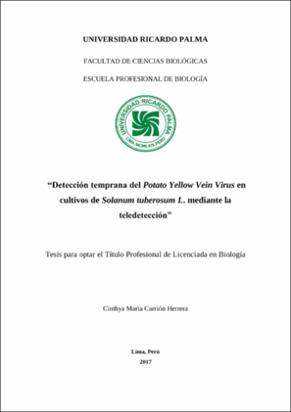Mostrar el registro sencillo del ítem
Detección temprana del Potato Yellow Vein Virus en cultivos de Solanum tuberosum L. mediante la teledetección.
| dc.contributor.advisor | Gonzales Molfino, Hugo Mauricio | |
| dc.contributor.author | Carrión Herrera, Cinthya María | |
| dc.date.accessioned | 2017-05-31T14:59:43Z | |
| dc.date.available | 2017-05-31T14:59:43Z | |
| dc.date.issued | 2016 | |
| dc.identifier.uri | https://hdl.handle.net/20.500.14138/901 | |
| dc.description.abstract | El Potato yellow vein virus (PYVV) es un Crinivirus perteneciente a la Familia Closteroviridae, el cual reduce la producción total de papa en América del Sur hasta un 50%. La detección visual de los cultivos es una práctica habitual, pero la enfermedad generalmente se detecta después de que se ha producido un daño significativo a los tejidos fotosintéticos. A través de técnicas de teledetección se puede evaluar el estado nutricional y fitosanitario de las plantas, detectando incidencias de plagas y enfermedades e inferir posibles carencias nutricionales. Con el objetivo de detectar la infección de PYVV en cultivos de papa antes de la aparición de los síntomas visuales se empleó la técnica de teledetección, mediante el uso del espectroradiómetro. Se llevaron a cabo 5 experimentos, empleando 5 variedades de papa: Única, Clon W.A., Canchan INIA, Amarillis y Costanera. La infección con PYVV fue inducida mediante injerto lateral. Se tomaron 3 mediciones espectroradiométricas por cada planta 2 veces por semana durante todo el periodo de observación y se realizó una evaluación visual continua de los síntomas. Asimismo, se confirmó la presencia del virus PYVV mediante RT-PCR. Finalmente, se evaluó el rendimiento de las 5 variedades y se identificó la variedad más susceptible al virus. Se pudo hacer un diagnóstico precoz de la infección por PYVV en las 5 variedades de papa. La variedad Canchan INIA se detectó entre 8 y 14 días antes de la aparición de los síntomas visuales, Única entre 7 y 18 días, Costanera entre 12 y 17 días, Amarillis entre 6 y 12 días, y finalmente Clon W.A. se pudo detectar entre 2 y 11 días antes de la aparición de los síntomas. La variedad Canchan INIA fue la variedad más susceptible al virus, ya que presentó el mayor porcentaje de reducción en el rendimiento, con un 36.63%, seguido de Costanera y Amarillis con un 28.57% y 28.31%, respectivamente. Clon W.A. fue la variedad menos afectada en cuando a la reducción en el rendimiento, con un 6.67%.Potato yellow vein virus (PYVV) is a Crinivirus belonging to the Closteroviridae Family, which reduces the total potato production in South America up to 50%. Visual detection of cultures is a common practice, but the disease is usually detected after significant damage to photosynthetic tissues has occurred. Through remote sensing techniques, it is possible to evaluate the nutritional and phytosanitary status of plants, detecting pest and disease incidences and inferring possible nutritional deficiencies. In order to detect PYVV infection in potato cultures before the appearance of visual symptoms, the technique of remote sensing was used, using the spectroradiometer. Five experiments were carried out, using 5 varieties of potato: Única, Clon W.A., Canchan INIA, Amarillis and Costanera. Infection with PYVV was induced by lateral grafting. Three spectroradiometric measurements were taken per plant 2 times per week throughout the observation period and a continuous visual evaluation of the symptoms was performed. Also, the presence of the PYVV virus was confirmed by RT-PCR. Finally, the yield of the 5 varieties was evaluated and the variety more susceptible to the virus was identified. An early diagnosis of PYVV infection could be made in all 5 potato varieties. Canchan INIA variety was detected between 8 and 14 days before the appearance of visual symptoms, Unica between 7 and 18 days, Costanera between 12 and 17 days, Amarillis between 6 and 12 days, and finally Clon W.A. could be detected between 2 and 11 days before the onset of symptoms. Canchan INIA variety was the most susceptible to the virus, as it presented the highest percentage reduction in yield, with 36.63%, followed by Costanera and Amarillis with 28.57% and 28.31%, respectively. Clon W.A. was the least affected variety when compared to the reduction in yield, with 6.67%. | es_ES |
| dc.description.sponsorship | Submitted by Wong Rafael (rafel_wl@hotmail.com) on 2017-05-31T14:59:43Z No. of bitstreams: 1 Carrión_cm.pdf: 5140767 bytes, checksum: 07083edabea796a5d6cf662501b4725c (MD5) | es_ES |
| dc.description.sponsorship | Made available in DSpace on 2017-05-31T14:59:43Z (GMT). No. of bitstreams: 1 Carrión_cm.pdf: 5140767 bytes, checksum: 07083edabea796a5d6cf662501b4725c (MD5) Previous issue date: 2016 | es_ES |
| dc.description.uri | Tesis | es_ES |
| dc.format | application/pdf | |
| dc.language.iso | spa | |
| dc.publisher | Universidad Ricardo Palma - URP | es_ES |
| dc.rights | info:eu-repo/semantics/openAccess | |
| dc.rights.uri | https://creativecommons.org/licenses/by-nc-nd/4.0/ | |
| dc.source | Repositorio Institucional - URP | es_ES |
| dc.subject | Potato yellow vein virus | es_ES |
| dc.subject | teledetección | es_ES |
| dc.subject | rendimiento | es_ES |
| dc.subject | síntomas visuales | es_ES |
| dc.title | Detección temprana del Potato Yellow Vein Virus en cultivos de Solanum tuberosum L. mediante la teledetección. | es_ES |
| dc.type | info:eu-repo/semantics/bachelorThesis | |
| thesis.degree.discipline | Biología | es_ES |
| thesis.degree.grantor | Universidad Ricardo Palma. Facultad de Ciencias Biológicas. Escuela Profesional de Biología | es_ES |
| thesis.degree.level | Título Profesional | es_ES |
| thesis.degree.name | Licenciada en Biología | es_ES |
| dc.publisher.country | PE | es_ES |
| renati.type | https://purl.org/pe-repo/renati/type#tesis | |
| renati.level | https://purl.org/pe-repo/renati/nivel#tituloProfesional | |
| renati.discipline | 511206 | |
| dc.type.version | info:eu-repo/semantics/publishedVersion |
Ficheros en el ítem
Este ítem aparece en la(s) siguiente(s) colección(ones)
-
Biología [176]


